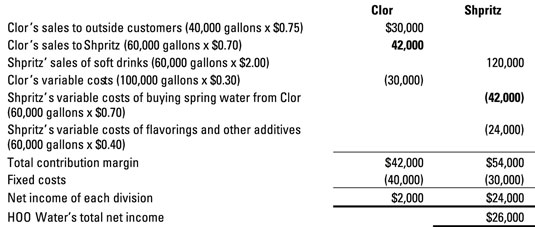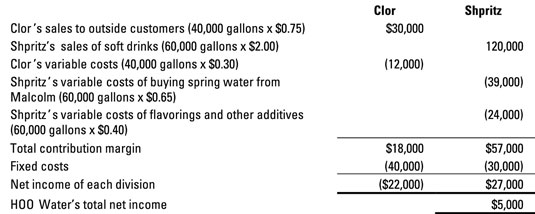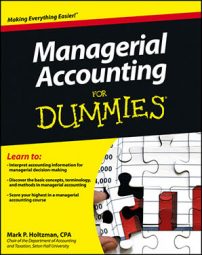A company may set the transfer price at full cost (also known as absorption cost), which is the sum of variable and fixed costs per unit. In order to ensure that the selling division earns a profit, they can also add a markup.
Suppose that HOO Water Company produces both spring water and soft drinks. The Clor division produces spring water, and the Shpritz division makes soft drinks. HOO managers encourage Clor and Shpritz to work together so that Shpritz division uses Clor division’s spring water to make its soft drinks.
However, Clor division also sells its water to outside customers for $0.75 per gallon. In order to minimize costs, Shpritz can also buy water from suppliers other than Spring.
This year, Clor division plans to produce 100,000 gallons of spring water but has the ability to produce more water if it can sell it. Clor’s water carries variable cost of $0.30 per gallon and must cover fixed costs of $40,000.
Shpritz division plans to make 60,000 gallons of soft drinks; it can buy the water from Shpritz or from an outside vendor. In addition to the cost of the water, Shpritz must pay $0.40 per gallon for flavorings and other additives to produce each gallon of soft drink. Shpritz also pays fixed costs of $30,000 per year. Shpritz’s soft drink sells for $2 per gallon.
First, compute Clor’s’s full cost. Fixed costs amount to $40,000 needed to produce 100,000 gallons of spring water. The fixed cost per unit, then, comes to $0.40 per gallon ($40,000 ÷ 100,000 gallons). Clor’s variable costs equal $0.30 per gallon; add that to the fixed cost per unit to get a total cost of $0.70 per gallon, the transfer price.
The following figure explains what happens when Clor supplies Shpritz with 60,000 worth of spring water for a transfer price of $0.70 per gallon and the rest to outside customers for $0.75 per gallon.

Here, Clor receives $30,000 in revenues from outside customers and $42,000 in revenues from Shpritz. Subtracting Clor’s variable costs of $30,000 and fixed costs of $40,000 results in net income of $2,000. Shpritz takes in revenues of $120,000 from its soft drinks.
Of this amount, it must pay $42,000 to Clor and $24,000 in other variable costs. Shpritz must also pay $30,000 worth of fixed costs, resulting in net income of $24,000 for Shpritz. HOO Water, which owns both divisions, earns a total income of $26,000 from both products.
Decisions to base transfer price on full cost can trick division managers into making bad decisions that hurt the overall company’s profitability. Suppose another company, Malcolm Water, sells water for $0.65 per gallon. (In case you’re wondering, Malcolm Water can charge less money for its water because its water is of poorer quality.) Shpritz division must choose between paying $0.70 per gallon to Clor division or $0.65 per gallon to Malcolm.
On one hand, Shpritz may prefer to do business with Clor just because both companies have the same parent. However, if HOO pays $0.70 a gallon to make water but only $0.65 to buy it from Malcolm, shouldn’t HOO just buy the water from the cheaper outside vendor and save $0.05 per gallon?
Not necessarily. The following figure illustrates the fiasco that occurs when Shpritz attempts to save money by buying its water from Malcolm.

Shpritz’s decision to try to cut costs reduces HOO Water’s overall profitability by $21,000. No question about it: Shpritz’s profitability goes up. Because the decision to outsource reduces the variable cost of buying water from $42,000 to $39,000, the net income of Shpritz rises to $27,000.
However, Shpritz’s decision hurts Clor and ultimately reduces HOO Water’s total profitability. Clor’s sales to Shpritz of $42,000 completely dry up. Its variable costs also drop from $30,000 to $12,000.
However, Clor’s fixed costs of $40,000 remain the same, forcing Clor to suffer a loss of $22,000. HOO Water’s overall profits fall from $26,000 to just $5,000. Basing the transfer price on full cost has led Shpritz to make decisions that hurt the company’s overall profitability.

